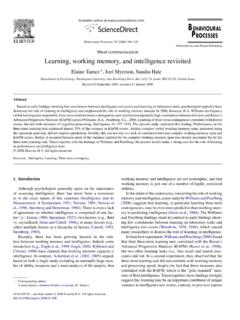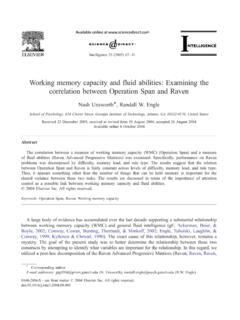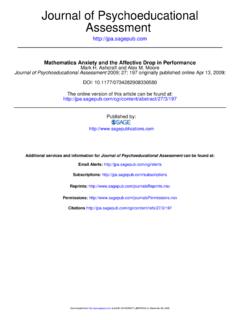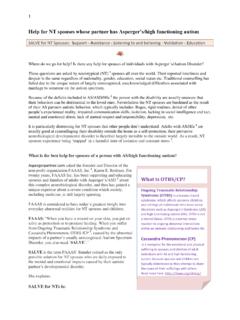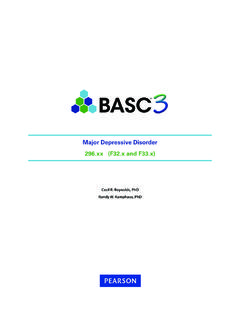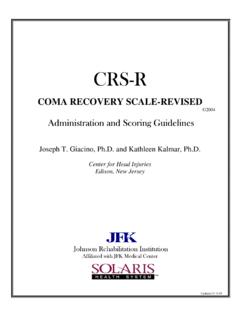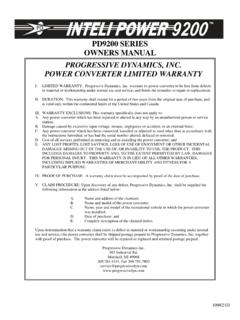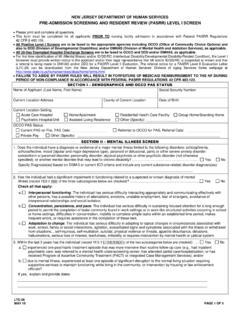Transcription of EEG Alpha Rhythm Frequency and Intelligence in …
1 Intelligence 23, 1-14 (1996). EEG Alpha Rhythm Frequency and Intelligence in normal Adults ANDREY ANOKHIN. Institute of Medical Psychology and Behavioral Neurobiology Tuebingen University, FR1 EDRICH V O G E L. Institute of Human Genetics, Heidelberg University Heidelberg, The electroencephalogram (EEG) reflects stable individual differences in brain function and therefore can be a powerful instrument for exploring the biological basis of intel- ligence. However, the question of whether the EEG, and, in particular, the Alpha Rhythm Frequency (AF) is related to Intelligence in normal adults remained unclear. We analyzed EEG spectra and performance on different Intelligence tests in 101 healthy males aged 20. to 45 (M IQ = ; SD = ) with a special regard to brain region and specific mental abilities.
2 Scores on Raven's Standard Progressive Matrices (SPM) correlated positively with AF in prefrontal and frontal regions. Verbal abilities factors derived from the verbal subtests of Amthauer's Intelligence Structure Test (IST) and Horn's LPS test of mental performance correlated positively with both mean and peak AF factors (r = .34 and .35, correspondingly; p < .001). However, AF did not show any significant relationship with the factors of general (g factor), spatial, and arithmetic abilities. INTRODUCTION. The understanding of the biological bases of Intelligence requires a detailed anal- ysis of the neurophysiological processes contributing to particular aspects of mental abilities. Despite the advent of modem brain imaging techniques, the electroencephalogram (EEG) still remains the main tool for investigating brain functioning in normal healthy humans.
3 The EEG shows a high interindividual variability, which is to a great extent genetically determined (for review, see van Beijsterveldt & Boomsma, 1994). However, the question of whether basic EEG. The authors thank Jens Kriiger and Edda Schalt for their help in arranging the EEG and psycho- logical database. We would like also to thank the referees for their useful comments. This work was supported by the Deutsche Forschungsgemeinschaft (DFG) grant to F. Vogel and by the Alexander von Humboldt Fellowship to A. Anokhin. Research for this article was supported by the Deutsche Forschungsgemeinschaft (DFG) grant to and by the Alexander von Humboldt Fellowship to Correspondence and requests for reprints should be sent to Andrey Anokhin, Dept. of Psychiatry, Washington University School of Medicine, 4625 Lindell Blvd.
4 , 2nd Floor, St. Louts, MO 63108. 2 ANOKHIN AND VOGEL. characteristics are associated with Intelligence in normal adults remained contro- versial. In this article, we consider one of the basic measures of background human EEG, the Frequency of Alpha Rhythm (AF). Alpha Rhythm is the most prominent component of the vast majority of human EEG records and is traditionally con- sidered to be the basic, dominant EEG Rhythm . There is multiple evidence that Alpha Rhythm recorded from the scalp represents neurophysiological mechanisms directly related to individual differences in information processing in the human brain (Klimesch, Schimke, & Pfurtscheller, 1993; Lebedev, 1990). Compared to amplitude and power measures of the Alpha Rhythm , AF is less influenced by extracerebral factors such as skull thickness or conductance and therefore its variation seems to result directly from the variation in brain function.
5 This EEG. parameter showed a good test-retest reliability (Anokhin, 1988; Deakin & Ex- ley, 1979; Gasser, Bacher, & Steinberg, 1985; Salinsky et al., 1991) and substan- tial heritability that has been demonstrated both on twins (Lykken, Tellegen, &. Thorkelson, 1974) and on families (Anokhin, 1988). The attempts to correlate EEG with Intelligence have a long history, and AF. was one of the first EEG indices tested for the possible relationship. The results of the early studies were rather inconsistent. Mundy-Castle (1958) and Mundy- Castle and Nelson (1960) reported a positive relationship, whereas in other studies no significant correlation could be found. In their review, Vogel and Broverman (1964) concluded that the available evidence supported the relation- ship between EEG and test Intelligence in individuals with either relatively un- developed intellectual function (children, mentally retarded) or deteriorated intellectual function (due to aging or brain damage), whereas in normal adults the relationship is very ambiguous.
6 Ellingson (1966) argued in his review that the weight of available evidence suggested no relationship between EEG and intel- ligence in normal adults. In another comprehensive review, Oswald and Roth (1974) noted that most EEG studies involving normal adults did not provide evidence for an association between AF and psychometric Intelligence ; the posi- tive findings available point to a possible relationship with performance rather than verbal IQ. Further studies could not clarify the issue. Giannitrapani (1969). reported a significant correlation between IQ and the average EEG Frequency (over all Frequency bands), as well as its asymmetry index in a relatively small group of adults (18 participants). In contrast, Vogel, Broverman, & Klaiber (1968) did not find any evidence that AF is related to general level of intel- ligence; however, it correlated with "automatization" cognitive style in their study.
7 They concluded that EEG indices seem to be related to particular cognitive factors, rather than to general mental ability. In another review, Oswald and Roth (1974) concluded that most EEG studies involving normal adults failed to pro- vide convincing evidence for the relationship between AF and test Intelligence ;. however, the authors noted that the few positive findings available suggest a relationship with performance IQ. Gasser, Von Lucadou-Miiller, Verleger, and EEG AND Intelligence 3. B~icher (1983) found a positive correlation between AF and IQ in a group of mildly retarded children, but failed to find such relationship in a group of normal children. Giannitrapani (1985) reported a significant correlation between domi- nant AF and Full-Scale IQ, as well as correlation of 13-Hz activity (the upper bound of the Alpha band) with verbal IQ in a sample of normal 11- to 13-year-old children.
8 The study of Juolasmaa et al. (1986) was most representative regarding sample size and methodologies and could shed more light on the issue. It in- volved a relatively large sample of 52 adult cardiac valvular patients. Although a portion of participants were supposed to have brain disorders due to an impaired cerebral circulation, the mean sample IQ was in the normal range. This study found significant correlations between AF and Intelligence test scores, mainly with verbal and memory subtests. Apart from possible correlations with Intelligence , there is strong evidence that AF is associated with memory performance and processing speed. Golubeva (1980) regarded Alpha Frequency as one of the indicators of the general central nervous system (CNS) activation factor and found significant correlation with performance on memory tasks.
9 Lebedev (1990) proposed a theoretical model that allows derivation of an individual's limit of short-term memory span from com- posite electrophysiological indices, based on AF and the duration of Alpha spin- dies. Klimesch et al. (1993) reported significant differences in Alpha Frequency between poor and good memory task performers, which were most pronounced when individuals actually retrieved information from their memory. Surwillo (1964) found that AF is negatively related to decision time in choice reaction task and hypothesized that the information capacity of the CNS is a function of EEG. period. Thus, although there are strong indications for the significance of AF for individual differences in mental performance, the question of whether AF is re- lated to test Intelligence in the normal adult population remained controversial.
10 This controversy has put into doubt the value of the EEG for Intelligence -related problems; and later biologically oriented studies of Intelligence employed more sophisticated measures of evoked potentials rather than spontaneous EEG (for review, see Barrett & Eysenck, 1994; Deary & Caryl, 1993). Inconsistent findings may result from a number of factors, some of which have been already mentioned by Gasser et al. (1983): (a) small sample size: in most studies, samples do not exceed 30 participants, which is too little for relia- bly detecting a correlation, which may be a priori expected to be rather modest;. (b) inclusion of participants with organic cerebral dysfunctions or~and impaired intellectual function in the sample: associations found in such cases may result from specific impairment of brain function and therefore cannot be simply ex- tended to the normal range; (c) effects of age: findings obtained on children, even if corrections for age effects are performed, cannot be extended to the adult population, because the correlation may result from the difference in develop- mental rate among individuals rather than from "true" individual differences, and 4 ANOKHINAND VOGEL.
